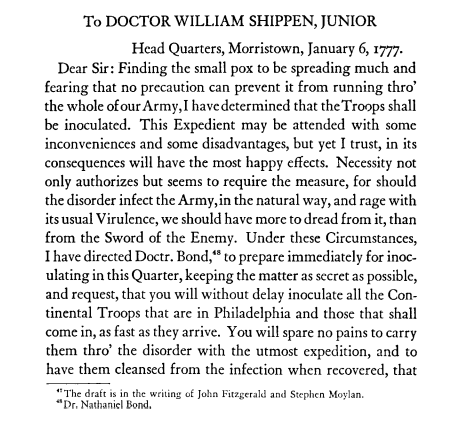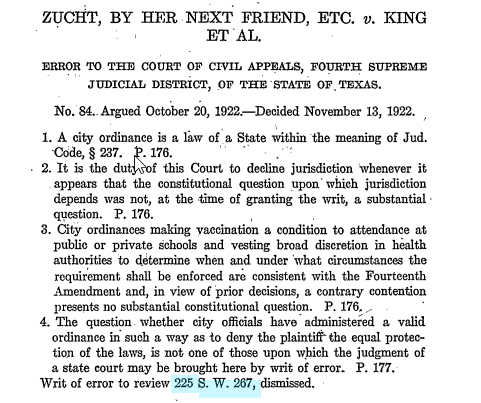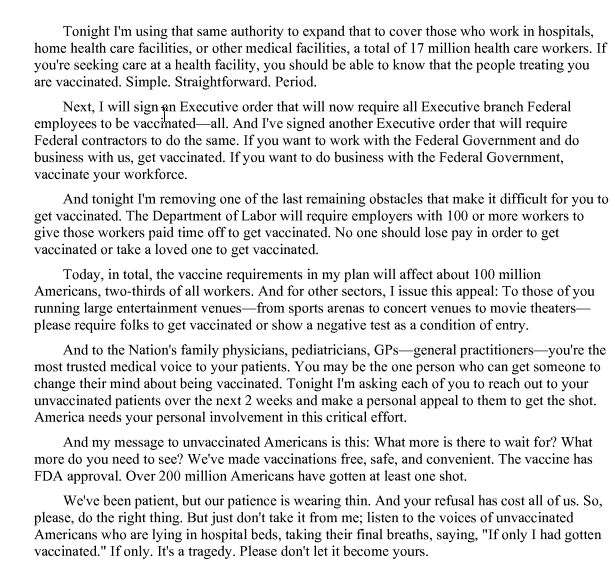A scabby, itchy pustule that left behind a permanent scar on the outside of the upper arm—as the main side effect of the smallpox vaccine, this scar was often used as a “vaccination passport,” proving inoculation for millions of Americans in the wake of vaccination mandates at the turn of the 20th century, when the highly contagious smallpox disease pummeled through communities. By 1980, the World Health Organization declared that this often-deadly virus which had been circulating the world for over 3,000 years had been eradicated.
Vaccination requirements aren’t new in the United States. Many infectious diseases have resulted in mandatory inoculations at the federal and state level—well before today’s health and safety measures were put into place. In the early days of our nation, colonial doctors used variolation—the process of using live smallpox virus from the pustules of an infected person and either rubbing them into a healthy person’s skin or having them breathe it in, creating a mild infection that was thought to provide protection from more severe disease. In 1777, pressure from the army led George Washington to mandate vaccinations. Regarding smallpox, he wrote, “we should have more to dread from it, than from the Sword of the Enemy,”[1]The Writings of George Washington is located within HeinOnline’s U.S. Presidential Library. Don’t subscribe? Learn more about the database. and the vaccinations were so successful that he was later inspired to write to his brother that, “I would rather move for a Law to compell the Masters of Families to inoculate every Child born within a certain limitted time under severe Penalties,” [2]The Writings of George Washington is located within HeinOnline’s U.S. Presidential Library. Don’t subscribe? Learn more about the database. [sic].

With the help of HeinOnline, let’s take a look at the relationship between government and vaccination through the years in the United States.
Spread Information with HeinOnline
Spreading information, not disease, is a good thing, and with millions of pages of primary and secondary sources, HeinOnline is a great way to stay informed on government, law, history, current events, and so many other subjects. For example, our COVID-19: Pandemics Past and Present collection compiles together publications on the various ways COVID-19 has impacted every aspect of life, organized into Economic Impact, Global Impact, Health Care Impact, and Societal Impact. In addition, the database features a subcollection dedicated to Past Pandemics, allowing researchers access to ways the federal government has responded to medical disasters of the past and how these previous pandemics inform today’s responses.

Smallpox: The First Modern Vaccine
In 1796, Dr. Edward Jenner created a successful (and much safer) vaccination against smallpox. He discovered that the cowpox virus, present in bovine and less deadly to humans, could protect against smallpox just as well as the actual smallpox virus. So, he began using pus from cowpox lesions to inoculate humans. His first test subject was an 8-year-old boy named James Phipps[3]The book Shots without Guns is located within HeinOnline’s Legal Classics database. Don’t subscribe? Learn more about the database.—Dr. Jenner scraped the pus[4]The book Shots without Guns is located within HeinOnline’s Legal Classics database. Don’t subscribe? Learn more about the database. from the cowpox-infected hands of dairymaid Sarah Nelmes and pricked it into the young boy’s upper arm.

With the success of the vaccine, and the worldwide smallpox outbreak that began in 1898, inoculation mandates were inevitable. And the measures taken were extreme—public health officials, accompanied by police officers, would barge into homes in the middle of the night to forcibly deliver the vaccination to the unwilling. Many public places, including schools and workplaces began to require proof of vaccination, either through a vaccination card (which, due to high rates of forging, soon lost their credibility) or through a visible scar on the upper arm. The tactics were successful—smallpox was officially eliminated from the world by 1980, which is considered one of the most significant public health achievements of all time.
The Rise of the Anti-Vaccination Movement
Mandatory vaccines have been controversial from the beginning. Common arguments include safety concerns, fear of exploitation at the hands of the government or pharmaceutical companies, as well as insistence that vaccine mandates infringe upon personal rights. And, historically, those who have opted to remain unvaccinated have benefited from herd immunity—the higher the percentage of the population that is vaccinated, the lower the risk of disease for everyone, including the unvaccinated. On the other hand, that means that the more people who refuse vaccination, the more difficult it becomes to reach herd immunity, thus putting the entire population at risk. At the core of the argument is the question of which is more important: individual freedom, or the interests of the community at large.
One of the most influential cases regarding the constitutionality of required vaccinations is Jacobsen v. Massachusetts.[5]This case is located within HeinOnline’s U.S. Supreme Court Library. Don’t subscribe? Learn more about the database. In February of 1902, a smallpox outbreak in Cambridge, Massachusetts, led the Board of Public Health to require all residents be vaccinated—or re-vaccinated if they had had a childhood inoculation. Henning Jacobsen, a local pastor, refused to be re-vaccinated, claiming that his childhood vaccination gave him a serious reaction. He was fined $5 but refused to pay it, arguing that the vaccine mandate wasn’t necessary and violated his rights. Anti-vaccination groups supported Jacobsen based on fears that the smallpox inoculation could cause permanent side effects and death.

Jacobsen lost the case, but his appeal eventually made its way to the Supreme Court, which rejected his defense that required inoculations go against the Fourteenth Amendment right to “life, liberty, and the pursuit of happiness.” The Court ruled that the mandate was constitutional because “the liberty secured by the Constitution of the United States to every person within its jurisdiction does not import an absolute right in each person to be, at all times and in all circumstances, wholly freed from restraint. There are manifold restraints to which every person is necessarily subject for the common good. On any other basis organized society could not exist with safety to its members.” [6]This case is located within HeinOnline’s U.S. Supreme Court Library. Don’t subscribe? Learn more about the database.
This case helped establish the “reasonableness” test which has since been used to determine the legality of mandatory vaccinations as well as other government decisions: Individual freedoms may be restricted by the government if doing so is necessary for the greater good of the public. However, the anti-vaccination movement returned around the 1970s when schools began mandating vaccinations for students.
Vaccinations and Education
Because of the high risk of disease outbreaks in schools and childcare facilities, every state has enacted vaccination mandates for education, with exemptions varying based on state. The first state to enact school vaccination requirements was Massachusetts in 1855, when the government required all children to receive the smallpox vaccine before attending school. Other states quickly followed suit.
In 1922, Rosalyn Zucht was denied entrance to public school in San Antonio, Texas, because her parents refused to vaccinate her. In the resulting case Zucht v. King,[7]This case is located within HeinOnline’s U.S. Supreme Court Library. Don’t subscribe? Learn more about the database. the Supreme Court, referring back to the Jacobsen case, denied that the vaccine mandate went against Zucht’s Fourteenth Amendment rights—her defense argued that education was essential to “life, liberty, and the pursuit of happiness.” The Court determined that the mandate was constitutional as it was necessary to protect the public from a smallpox outbreak.

Similarly, in the 1980s, Maricopa County, Arizona, experienced a measles outbreak, prompting schools to restrict unvaccinated children from attending. In the case Maricopa County Health Department v. Harmon,[8]This case is located within the Fastcase library. Don’t subscribe? Learn more about the database. the court again referred to Jacobsen, ruling that it was reasonable for unvaccinated students to be refused school attendance to protect the public good. The court also went on to note that mandatory vaccinations can still be considered reasonable even without the existence of an epidemic.
Exceptions to the Rule
Vaccines are never 100% effective or safe for everybody. To accommodate for this, all 50 states have a medical exemption to mandatory vaccinations, meaning that those who are deemed by a doctor to be medically unfit for vaccination are exempt to the mandate. In addition, 44 states allow for religious exemptions from vaccines—however, many states require those seeking this type of exemption to provide proof of their religious devotion and the sincerity of their beliefs. Fifteen states allow for philosophic or personal belief exemptions. It has been found that outbreaks of vaccine-prevented diseases, like polio and measles, are more common among religious groups with low vaccination rates, such as the Amish.
But exemptions aren’t always recognized. For example, in the court case Wright v. DeWitt School District,[9]This case is located within the Fastcase library. Don’t subscribe? Learn more about the database. the court ruled that the First Amendment right to freedom of religion doesn’t apply to using religion as a reason to avoid school vaccination requirements that are enacted for public health.
The COVID-19 Vaccine & the Law
Fast-forward to today: The COVID-19 pandemic has claimed the lives of millions of people around the world and has, in one way or another, affected every single person in the United States. Vaccinations became available to the general public in the early spring, and many jumped at the chance to reduce their risk of severe disease. However, others held off due to fear of side effects, doubt at the vaccines’ efficacy, and concerns about the speed at which the vaccines were created. As a result, the United States hasn’t reached herd immunity, and the Delta variant has begun infecting both vaccinated and unvaccinated people across the country, although the vaccinations drastically reduce the chance of severe symptoms.
As concerns begin to rise about the vulnerability of children, who are not yet authorized for vaccination, as well as the development of a vaccine-resistant variant, the government has started to step in to increase vaccination rates. On July 26, 2021, the U.S. Department of Veterans Affairs became the first federal agency to require employees to receive the COVID-19 vaccine by mandating it for VA healthcare workers. Shortly after, on July 29, President Biden announced all federal workers and contractors would need to be vaccinated[10]These presidential remarks are located within the U.S. Presidential Library. Don’t subscribe? Learn more about the database. or receive weekly COVID-19 tests among other precautions. Most recently, on September 9, Biden announced that most federal workers and contractors would need to be vaccinated, and all employers with 100 or more employees would need to require vaccinations or weekly testing. He stated, “We’ve been patient. But our patience is wearing thin, and your refusal has cost all of us.”[11]These presidential remarks are located within the U.S. Presidential Library. Don’t subscribe? Learn more about the database.

In New York State, a vaccine mandate has just gone into effect for healthcare workers—those who don’t comply will be dismissed or put on unpaid leave. Governor Kathy Hochul has announced that she plans to work with healthcare facilities to fill staff shortages with out-of-state healthcare workers or members of the National Guard.
These mandates aren’t anything new—and neither is the opposition to them. However, in a world with global travel and an ever-increasing population, spreading illness is so much easier, and refusing vaccination can have wide-reaching consequences.
Get Your Dose of the HeinOnline Blog
Our blog is where we show you tips and tricks for exploring the databases, updates on new content, uncovered history from within HeinOnline, and more. Make sure you’re subscribed so you can get posts delivered right to your inbox!
HeinOnline Sources[+]
| ↑1, ↑2 | The Writings of George Washington is located within HeinOnline’s U.S. Presidential Library. Don’t subscribe? Learn more about the database. |
|---|---|
| ↑3, ↑4 | The book Shots without Guns is located within HeinOnline’s Legal Classics database. Don’t subscribe? Learn more about the database. |
| ↑5, ↑6, ↑7 | This case is located within HeinOnline’s U.S. Supreme Court Library. Don’t subscribe? Learn more about the database. |
| ↑8, ↑9 | This case is located within the Fastcase library. Don’t subscribe? Learn more about the database. |
| ↑10, ↑11 | These presidential remarks are located within the U.S. Presidential Library. Don’t subscribe? Learn more about the database. |



